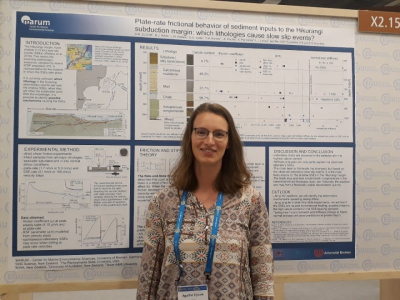Aagje Eijsink
Report of GLOMAR PhD student Aagje Eijsink about her participation in the European Geosciences Union General Assembly (EGU) 2019 in Wien, Austria from 7 to 12 April
The EGU General Assembly is a very large conference for geoscientists mostly from Europe, but also from the rest of the world. This year, there were 16,273 participants from 113 countries. My poster was one of 9423 in total. Since it is so big, the session can be quite specific and luckily there was one that fit my work perfectly. My poster, titled “Plate-rate frictional behavior of sediment inputs to the Hikurangi subduction margin: which lithologies cause slow slip events?” fit perfectly within the session “Earthquakes: from slow to fast, form the field to the laboratory and models”. I was very happy I had the opportunity to present and discuss my work with other scientists working on slow earthquakes.
Apart from my own session, there were many more orals and posters that were interesting for my current research. This ranged from theoretical friction laws to statistical analyses of slow slip events to other people working on the same location, but on completely different topics. Next to the oral, poster and PICO presentations, there were also short courses of which I attended seismology 101. This because I work with earthquakes, but I thought I knew next to nothing about detecting them. Although the short course was a nice break from the many orals and poster sessions, I realized I picked up quite some seismology over the years and the short course was too basic for me.
One of my personal highlights of the conference was a medal lecture by Chris Marone, one of the important people in lab friction and slow earthquakes. His lecture titled “the mechanics of slow slip and lab earthquake prediction” was very inspiring. During the drinks after this lecture as well as throughout the entire conference, I met many new people who work with rock friction and I had the chance to meet up again with my former supervisors from Utrecht University and Cardiff University. I also ran into many people I used to study with who now do PhDs all over Europe, which was also great.
Altogether, EGU was a very good experience for me, both for presenting my work and connecting to people. I am very grateful to GLOMAR for providing the financial means that allowed me to go. I would recommend it to all other PhD students who work in geoscience, because it is large enough to always meet people who work on a similar topic, but it is so well organized that I did not feel overwhelmed by the size.



